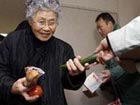| Videos | ? Latest |
|
? Feature | ? Sports | ? Your Videos |
Quake survivors face shortages of food and water

Japan's Kyodo News Agency, says about 300-thousand people have been evacuated nationwide. Many earthquake victims, are taking refuge in schools and other emergency shelters. But as our reporter tells us, they're now face mounting pressures, from food and water shortages.
Residents of northern Japan face another day in temporary shelters. With access to the disaster zone cut off, the shipment of goods, especially food and drinking water, remains blocked in the city of Sendai.
Earthquake Survivor, Sendai Shelter, said, "My home is gone completely, and it's dangerous to go back there. Here only children and seniors at, and above, 75 years of age are entitled to food rations."
Due to the continuing aftershocks, shelters present the best refuge most displaced survivors can find, for the time being.
To many, the horrors of last Friday's devastating earthquake and raging tsunami are still much too fresh.
Harue Watanabe, Futaba Evacuee, said, "I was swept away by the tsunami, and the water level went up to my chest. Only once I was 100 meters away did I start to feel safe."
The massive tremor also damaged nuclear power plants in the country's northeast region. Local residents are now questioning whether atomic energy is really the best option.
Masao Sakai, Northeast Japan Resident, said, "Although there may be reason to use them, in order to combat climate change, when something like this happens, it makes you wonder if we should rethink using nuclear power."
With more than one million people without water or power, and entire towns wiped off the map, Japan is seriously struggling to respond to a disaster of epic proportions.
 0
0 






